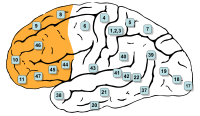
Photo from wikipedia
Objective Accumulated evidence collected via functional near-infrared spectroscopy (fNIRS) has been reported with regard to mental disorders. A previous finding revealed that emotional words evoke left frontal cortex activity in… Click to show full abstract
Objective Accumulated evidence collected via functional near-infrared spectroscopy (fNIRS) has been reported with regard to mental disorders. A previous finding revealed that emotional words evoke left frontal cortex activity in patients with depression. The primary aim of the current study was to replicate this finding using an independent dataset and evaluate the brain region associated with the severity of depression using an emotional Stroop task. Methods Oxygenized and deoxygenized hemoglobin recording in the brain by fNIRS on 14 MDD patients and 20 normal controls. Results Hyperactivated oxygenized hemoglobin was observed in the left frontal cortex on exposure to unfavorable stimuli, but no significant difference was found among patients with depression compared with healthy controls on exposure to favorable stimuli. This result is consistent with previous findings. Moreover, an evoked wave associated with the left upper frontal cortex on favorable stimuli was inversely correlated with the severity of depression. Conclusion Our current work using fNIRS provides a potential clue regarding the location of depression symptom severity in the left upper frontal cortex. Future studies should verify our findings and expand them into a precise etiology of depression.
Journal Title: Psychiatry Investigation
Year Published: 2019
Link to full text (if available)
Share on Social Media: Sign Up to like & get
recommendations!